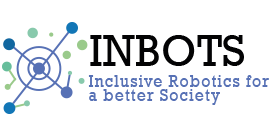
One of the objectives of INBOTS is to promote societal and socio-economic uptake of robotics. The project has a specific work package for this purpose, led by KTH Royal Institute of Technology. This work package collects best practices of new robotic applications, grasp the societal values, needs and expectations of robotics and what specific robotic applications are needed, and identify a set of key areas where the potential to meet society’s needs is ethically acceptable and socially desirable. It also brings together a variety of stakeholders to exchange ideas and expertise, and bringing attention to the connection between robotics development and societal development. More information about this work carried out can be found here.
We have been talking with Britt Östlund, a professorship in Technology in Health Care at KHT and leader of this work package, to know about the progression of these tasks, and how are they contributing to the uptake of robotics by the general public and consumers.
The aim of WP6 is to promote robotics uptake by the general public, can you briefly identify the main gaps and needs related to the current level of understanding of robotics by the general public? Which are the most complicated to deal with?
Initially, this Work Package analyzed social uptake of interactive robots in Europe using available statistics and best practices provided by INBOTS partners. At a later stage, these best practices were evaluated according to their adoption potential and innovative maturity. The result proves that interactive robots reached different stages of maturity in different sectors. Although social uptake in this Work Package refers to the use of interactive robots outside the industry, this is an important reference point. The industry is at the leading edge including manufacturing, logistics, rescue activities and exoskeletons. A promising area with a number of applications implemented is education. Health care includes advanced robots that have been used for a while such as robotized assistance for surgery and robots for social care. The latter which, despite great interest, shows a slower development seems to be gaining momentum now. The vast majority of interactive robot applications are part of a biomedical framework based on medical needs and replacements or support for bodily functions, which is reflected in the yearly Cybathlon and Eurobench promoting exoskeletons, prosthesis and humanoids.
The vast majority of interactive robot applications are part of a biomedical framework based on medical needs and replacements or support for bodily functions
Interactive robots may definitely meet a broader range of needs but the path to use is not straightforward. A more well-founded contextualization of robotic applications to fit the social framework in which they are implemented, as well as regulations on a European level belongs to what requires improvements. Lack of access to statistics about social uptake and acceptance Europe-wide is a problem that tend to lower the speed and target fulfilment. Without statistics on the social uptake and use of digital resources policy makers are flying blind. Another aspect that should be considered is how the usability of these robots is evaluated and to what extent users and consumers are able to influence development, design and evaluation of new robot applications. Are there even sufficient methods to explore needs and requirements in contexts not yet recognized for robotic developments
INBOTS has defined a common strategy to increase public awareness about IR, can you tell us about the highlights of this strategy?
Well, the efforts following the invention and evaluating of interactive robotic best practices has not been the general public but rather businesses, especially enterprises interested to diversify their production and design to enter the market of growing care needs. This also includes public procurement which provides challenges different from the consumer market. In 2019 two workshops with businesses were planned and one took place in Madrid due to the breakout of the coronavirus. When the corona epidemic broke through our Work Package changed their efforts into webinars and conference arrangements went digital.
Can you tell us about some specific actions you have taken to bring robotics closer to the public? Which has been best received by the public?

The CYBATHLON Symposium took place in a fully virtual format in September 2020 dedicated to the user-driven design approach and evaluation of assistive technology. This Work Package engaged in available digital business networks such as Aging2.0 that attended a growing interest from both entrepreneurs and the public. Hackathons were arranged with students and seniors in Stockholm. Two webinars were conducted in June, focusing on to what extent the corona epidemic is speeding up digitization of elderly care; and to what extent our images of older users are up to date.
A symposium with the title: Robotizing health care, what can be further automated? Was conducted and pre-recorded in zoom for the International Gerontechnology Conference in October 2020.
Where is the robotics market heading and what will be the next challenges to face regarding promotion of robotics to be uptake by general public?
This is a question to be discussed in the project in the coming months. We have still time to keep working and moving forward, so we will be able to answer this in a few months.
What company did you know during the project that you found interesting?
Cybathlon is continuously maintaining and developing contacts with companies relevant for exoskeletons, prosthetics and humanoids. New initiatives such as Aging 2.0 business networks focus new markets coming out demographic developments; robots for longer life and robots for growing older populations.
